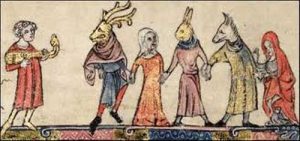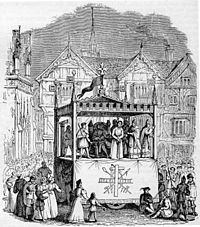Medieval Theater: yep, people have been running around and saying crazy stuff on stage to a less-than-knowledgeable audience ever since the Dark Ages. However, as much as it has stayed the same, theater way back when definitely had its own distinguishable category in the history of live theater.
Theater performances around the Medieval time period started in the Church and were specifically designed for the Church. Before 1200 most plays were still being done in Latin and inside Mansions or Plateas. Mansions were specific scene structures created to indicate location. Plateas were general acting areas, usually adjacent to the Mansions. The physical church building usually served as the Mansion, for example, the altar could serve as Jesus’s tomb and the loft could serve as Heaven. By 1200, some of these plays were moving outside due to size and demand. Most of the plays were focused around religious retellings or beliefs; it was a fundamental way to inform the common people of bible stories and teach them how they should be living in regards to their faith. By 1350, the plays were now recited in the vernacular and had moved almost completely outside of the church, showing a fundamental shift in the control of the Catholic church. The church no longer controlled every aspect of social and religious life. As secularization began, theater became less for church purposes and more for social purposes, shifting outside of church control.
Around 1500, performances took place almost solely outside of the church. Plays outside the Church still existed to teach and promote Bible teachings and themes. The plays themselves, however, became more than just re-telling bible and hero stories. They now incorporated anachronisms and comedic elements to create an actual story with complex characters and a hidden moral. The audience was usually the common people who had very low literacy rates, resulting in the plays containing no references to historical events and ignoring historical timelines, as the audience had very little knowledge about such things. The plays themselves were performed in cycles, with different plays being performed in the same sequence at different towns and events every few days depending on the time of year and event. Typically there were three types of plays, Mystery, Miracle, and Morality. The mystery plays focused on Christ and the Old Testament (The Second Shepard’s Play). This was the most common form to be performed cyclically. The miracle plays focused on the lives of the Saints, both historical and legendary. Lastly, the Morality plays usually depicted the common man’s quest for salvation and his challenges along the way. All their motives remained consistent, to reinforce religious doctrine all while entertaining and educating at the same time.
Although they were less common, there were secular plays occurring around this time period (1500) as well. Farces were very popular. There were three types: moralities, mummings and interludes. Moralities focused on political content and allegories based on Greek gods and heroes. Mummings were narrated stories you could dance to, usually given at wealthy homes for special occasions. Interludes were performed between the courses of meals, usually focusing on allegorical compliments to the guests. Most often these non-religious plays were performed by professional working actors.
One of the most distinctive and defining characteristics of medieval theater was the simultaneous staging. There were two distinguishable types, fixed and moveable. Fixed staging had mansions set up in a certain design depending on the stage. Moveable staging was a wagon that moved through the streets performing plays over and over again while the audience stayed in the same place. The most important people in the play were the actors, Keeper of the Register and the Master of Secrets. The actors obviously performed the play and entertained the audience. The play itself was written on usually a piece of animal skin called the register and the Keeper of the Register was in charge of keeping it safe and directed many of the aspects of the rest of the play. The Master of Secrets was in charge of special effects. The most common techniques were flying, trap doors and fire. Often these techniques were very intricate, often taking up to 20 people to hoist people up during flying scenes.
Theater is just words and actions being performed in front of an audience, yet it and it’s culture has still evolved and increasingly changed with time. The current theater industry is very different than what the industry was back in the medieval times. Analyzing medieval theater gives us a glimpse into the culture and daily lives of those living in that time period and comparing it to the current theater industry reflect the evolutions of society throughout history. Proving once and for all, that life does indeed imitate life.
More Information:
http://novaonline.nvcc.edu/eli/spd130et/medieval.htm
http://www.medievalchronicles.com/medieval-life/medieval-theatre-images/
http://www.thefinertimes.com/Middle-Ages/theatre-in-the-middle-ages.html


